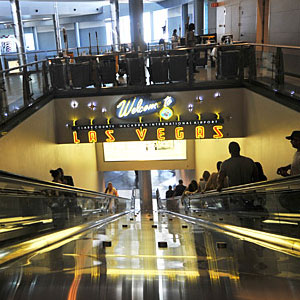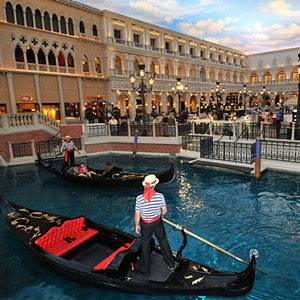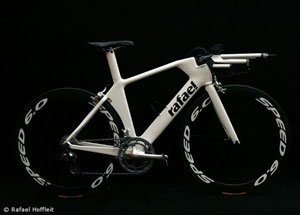The Last Vegas Interbike

The focus is changing at America's premier bike industry trade show. In fact, as you might already know, the show is changing. Literally. This is its last year in Las Vegas. Next year the show will be in Anaheim, and it'll be 6 weeks in advance of when it's traditionally been.
This, because the season has changed. And this, because the suppliers have changed. Because bikes are almost entirely built in the Orient—the components and the frames both—lead times have gotten longer, and orders need to be in. So most of the major bike companies have already finished their subsequent year's lines, sent out their salesmen, taken the orders, well before Interbike even takes place.
This makes Interbike something other than a writing show. For the major bike companies, Interbike is largely irrelevant. Therefore, many of these large bike companies are not in attendance, or are marginally here. Interbike is hoping that a show just after the Tour de France finishes will lure the major brands back.
For this reason, a lot of what I'll be looking for at this final Vegas Interbike is what the smaller brands are doing.
They're going to have to fight hard, because the landscape has changed. Used to be, the niche brands had it all over the larger bike companies that didn't understand triathlon, and were too cumbersome to adapt.

The reason smaller, niche triathlon bike companies have a fight on their hands has been a decade in the making. Fifteen or twenty years ago it was almost unheard of for a non-European bike maker to have its bikes ridden by a top European cycling team. Notice now that these teams are sponsored by the likes of Specialized, Trek, Scott, Cannondale, Felt, Cervelo, Giant. Furthermore, these larger companies seem to get their pick of the litter of the pro teams racing.
Concurrently, the strategy of the grand tours evolved. No longer was the race won solely in the mountains, it was also won during the timed events. These teams started demanding top timed race bikes of their sponsors.
Finally, the nature of the tri market changed. Specifically, it grew. And it continues to grow in spite of a recession.
All of this conspired to focus the engineering and sales energy of these larger, full service companies on their timed race category. And because these companies offer financing and incentives to their dealer base—and they get at that dealer base with their salesmen months earlier than do the niche brands, sucking up these retailers' "open to buy" dollars—pressure is placed on the niche brands who want to sell their tri bikes.
On the flip side, niche tri bike makers have the luxury of waiting a bit longer to finalized their subsequent years' lineups. Larger flagship companies have frequently shown their timed race bikes at Interbike or earlier, only to miss the Spring ship deadlines. Last year's Plasma 3 was in Scott's booth, but won't make it to retail stores until the 2011 season. Trek's Speed Concept was introduced after the largest part of the pro bike selling season was over.

Finally, what you don't get from the small companies is design by committee. Look at a Rafael and then tell me who makes your favorite, cost no object, superbike. How many companies like Rafael will I see at Vegas this week?
But what I really hope to see are the new aerobars. Frame design has outpaced advancements in aerobars. And what about the accessories that bolt to bikes to keep them aerodynamic? What you don't see tested in wind tunnels are bikes as they are actually ridden, with water bottles, and powermeter and computer wires zip tied from back to front; gels taped in a cascade on top of the top tube; spare tires attached to any unused piece of real estate.
Trek and Cervelo took steps forward, consideration finally given to where water and "stuff" will reside on the bike during a race—Felt likewise with its DA's behind-the-seatpost Di2 battery bosses. But I have to think there's a cottage industry out there, making all the stuff you can bolt onto the bosses these various companies grant you.
I'll be looking for other, smaller things that make life a little easier for us all. I hope I find brake calipers that are easier to adjust for the bikes that have their calipers mounted in non-traditional places. I hope I find eyewear for the bike that features better visibility while riding in the aero position. I'm looking forward to seeing De Soto's bib tri shorts: These sound right up my alley.
I hope I find new bike fit tools: fit bikes and X/Y tools that adjust in ways that work for tri bike fit protocols. I hope I see new and better electronics and information devices. Mostly, I hope I see that manufacturers have come to the show ready—intellectually ready—to sell to the triathlon market.
Herbert Krabel, our editor-in-chief, will also be reporting from Interbike. While he and I are on the same team, I rarely see Herbert at the show—he's in one part of the hall, finding something I missed, and I'm somewhere else, squinting through my reading glasses at something else. We'll each be filing our reports.
I confess a little nostalgia for the place. I hate Las Vegas. I hate what it stands for. I've hollered for the show to be moved. Now that it is moving, I wonder if my daily morning loops ridden around Red Rock Canyon—and the one hour run around White Mountain adjacent to Red Rock's Calico Mountains—will be my last. Probably so.

